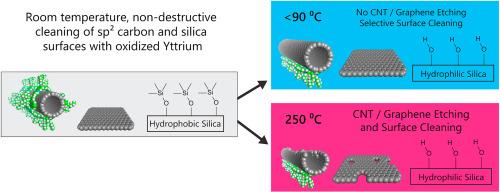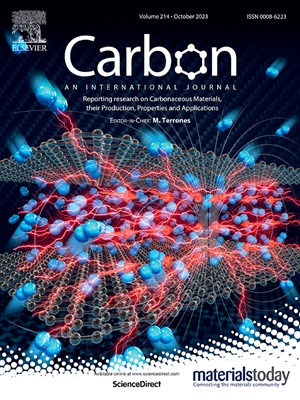利用活性钇薄膜选择性氧化和去除碳纳米管中的碳氢化合物
IF 10.5
2区 材料科学
Q1 CHEMISTRY, PHYSICAL
引用次数: 0
摘要
包裹聚合物可用于在有机溶剂中分选高纯度的半导体碳纳米管(CNT)悬浮液,但在许多微电子应用中需要去除包裹聚合物。在包裹的碳纳米管上涂上金属钇,然后用稀释的水性酸进行氧化和去除,已被用于蚀刻包裹聚合物,但其机制、选择性、蚀刻程度以及发生蚀刻的条件范围尚未见报道。我们利用光谱和物理测量方法,对典型共轭包裹聚合物(PFO-BPy)薄膜、其无定形炭残留物、CNT(平均直径 1.5 纳米)、石墨烯和其他有机薄膜的蚀刻过程进行了表征。将 PFO-BPy 的钇涂层薄膜暴露在 20 °C 的环境空气中,会氧化 0.5 nm 的聚合物层,形成碳酸盐、羧酸盐和/或羰基,这些基团会溶解在稀酸中。反复循环可去除较厚的聚合物层。其他有机薄膜在 20 °C 下也能观察到类似的结果,而 CNT 和石墨烯却没有发生变化,这为从 sp2 碳基纳米结构中去除碳基污染物提供了所需的选择性。将温度升高到 250 °C,聚合物的氧化和去除率会增加到每周期 2.5 nm;但 CNT 和石墨烯会受到损坏。本文章由计算机程序翻译,如有差异,请以英文原文为准。

Selective oxidation and removal of hydrocarbons from carbon nanotubes using reactive yttrium films
Wrapping polymers are useful for sorting high purity suspensions of semiconducting carbon nanotubes (CNTs) in organic solvents, but for many microelectronic applications the wroapping polymer needs to be removed. Coating wrapped CNTs with yttrium metal, followed by oxidation and removal with dilute aqueous acid, has been used to etch wrapping polymer, but the mechanism, selectivity, extent of etching, and range of conditions over which etching occurs have not been reported. We use spectroscopic and physical measurements to characterize this process on thin films of an archetypical conjugated wrapping polymer (PFO-BPy), its amorphous char residue, CNTs (average diameter 1.5 nm), graphene, and other organic films. Exposure of a yttrium overcoated film of PFO-BPy to ambient air at 20 °C oxidizes a ∼0.5 nm layer of polymer, forming carbonate, carboxylate, and/or carbonyl groups that dissolve in dilute acid. Thicker layers of polymer are removed by repeated cycles. Similar results are observed for other organic films at 20 °C whereas CNTs and graphene are unaltered, providing the selectivity needed to remove carbon-based contaminants from sp2 carbon based nanostructures. Increasing temperature to 250 °C increases polymer oxidation and removal to ∼2.5 nm per cycle; however, the CNTs and graphene are damaged.
求助全文
通过发布文献求助,成功后即可免费获取论文全文。
去求助
来源期刊

Carbon
工程技术-材料科学:综合
CiteScore
20.80
自引率
7.30%
发文量
0
审稿时长
23 days
期刊介绍:
The journal Carbon is an international multidisciplinary forum for communicating scientific advances in the field of carbon materials. It reports new findings related to the formation, structure, properties, behaviors, and technological applications of carbons. Carbons are a broad class of ordered or disordered solid phases composed primarily of elemental carbon, including but not limited to carbon black, carbon fibers and filaments, carbon nanotubes, diamond and diamond-like carbon, fullerenes, glassy carbon, graphite, graphene, graphene-oxide, porous carbons, pyrolytic carbon, and other sp2 and non-sp2 hybridized carbon systems. Carbon is the companion title to the open access journal Carbon Trends. Relevant application areas for carbon materials include biology and medicine, catalysis, electronic, optoelectronic, spintronic, high-frequency, and photonic devices, energy storage and conversion systems, environmental applications and water treatment, smart materials and systems, and structural and thermal applications.
 求助内容:
求助内容: 应助结果提醒方式:
应助结果提醒方式:


